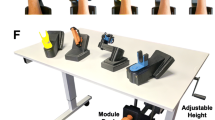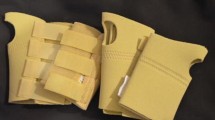Abstract
Objectives: To examine the reliability of manual tracking performance and its association with impairment and disability in individuals symptomatic of an upper extremity cumulative trauma disorder (CTD). Methods: Volunteer and physician referred subjects (100 control, 140 CTD) tracked a target cursor moving quasi-randomly using a hand-held stylus interfaced with a digitizing tablet. Impairment was physician-rated and the Disability of the Arm, Shoulder and Hand questionnaire measured disability. Subsamples of 25 subjects per group were tested on three occasions. Results: Reliability of tracking performance was excellent (ICC ≥ 0.88) and sensitivity was 81%. Performance was superior in controls (p < 0.001) and deteriorated as a function of impairment level (p < 0.001). Tracking and impairment rating explained 65% of the disability score. Conclusions: Tracking performance may be an important outcome for monitoring change over time and the impact of a CTD on function in everyday activities.



Similar content being viewed by others
References
Walker-Bone K, Cooper C. Hard work never hurt anyone: or did it? A review of occupational associations with soft tissue musculoskeletal disorders of the neck and upper limb. Ann Rheum Dis 2005;64: 1391–6.
Melhorn JM. Cumulative trauma disorders and repetitive strain injuries. The future. Clin Orthop Rel Res 1998;351:107–26.
Friedman PJ. Predictors of work disability in work-related upper extremity disorders. J Occup Environ Med 1997;39:339–43.
United States Department of Labor Bureau of Labor Statistics, Washington, DC 20212-0001. www.bls.gov, 2001.
Stumpp D, Sparks P. Screening and medical surveillance for cumulative trauma disorders. In: Erdil M, Dickerson OB, editors. Cumulative Trauma Disorders; Prevention, Evaluation, and Treatment. New York: Van Nostrand Reinhold; 1997. p. 203–20.
Katz JN, Gelberman RH, Wright EA, Lew RA, Liang MH. Responsiveness of self-reported and objective measures of disease severity in carpal tunnel syndrome. Med Care 1994;32:1127–33.
Kuschner SH, Ebramzadeh E, Johnson D, Brien WW, Sherman R. Tinel's sign and Phalen's test in carpal tunnel syndrome. Orthop 1992;15:1297–302.
Pascarelli EF, Hsu Y-P. Understanding work-related upper extremity disorders: clinical findings in 485 computer users, musicians, and others. J Occup Rehabil 2001;11:1–21
Wilson JJ, Best TM. Common overuse tendon problems: a review and recommendations for treatment. Am Fam Physician 2005;72:811–8.
Silverstein B, Welp E, Nelson N, Kalat J. Claims incidence of work-related disorders of the upper extremities: Washington State, 1987 through 1995. Am J Public Health 1998;88:1827–33.
Feuerstein M, Miller VL, Burrell LM, Berger R. Occupational upper extremity disorders in the federal workforce: Prevalence, health care expenditures, and patterns of work disability. J Occup Environ Med 1998;40(6):546–55.
Bongers PM, De WC, Kompier MA, Hildebrandt VH. Psychosocial factors at work and musculoskeletal disease. Scand J Work Environ Health 1993;19:297–312.
Estlander AM, Takala EP, Viikari-Juntura E. Do psychological factors predict changes in musculoskeletal pain? A prospective, two-year follow-up study of a working population. J Occup Environ Med 1998;40:445–53.
Fitzpatrick F, Badley EM. An overview of disability. Brit J Rheumatol 1996;35:184–87.
McFarlane GJ, Hunt IM, Silman AJ. Role of mechanical and psychosocial factors in the onset of forearm pain: prospective population based study. BMJ 2000;321:1–5.
World Health Organization (WHO) Towards a common language for functioning and disablement: ICIDH-2 (Geneva: WHO); 1998
Shaw WS, Feuerstein M, Lincoln AE, Miller VI, Wood PM. Ergonomic and psychosocial factors affect daily function in workers’ compensation claimant with persistent upper extremity disorders. J Occup Environ Med 2002;44:606–15.
Brouwer B, Mazzoni C, Pearce GW. Tracking ability in subjects symptomatic of cumulative trauma disorder: does it relate to disability? Ergonomics 2001;44:443–56.
Carey JR, Baxter TL, Di Fabio RP. Tracking control in the nonparetic hand of subjects with stroke. Arch Phys Med Rehabil 1998;79:435–41.
McConnell S, Beaton DE, Bombardier C. The DASH outcome measure User's Manual. Toronto Ontario: Institute for Work and Health, 1999.
Beaton DE, Katz JN, Fossel AH, Wright JG, Tarasuk V, Bombardier C. Measuring the whole or the parts? Validity, reliability, and responsiveness of the Disabilities of the Arm, Shoulder and Hand outcome measure in different regions of the upper extremity. J Hand Ther 2001;14:128–46
Portney LG, Watkins MP. Foundations of clinical research- Applications to practice, (1st Edition). East Norwalk, CT: Appelton & Lange, 1993.
Moon S, Brigham C, Sydnor M. Cumulative trauma disorders: impairment and disability assessment. In: Erdil M, Dickerson OB, editors. Cumulative trauma disorders: prevention, evaluation and treatment. New York: Van Nostrand Reinholdt; 1997. p. 385-438.
McDermott FT. Repetition strain injury: a review of current understanding. Med J Austr 1986;144:196–200.
Wei S, Huang S-L, Jiang C-J, Chu J-C. Wrist kinematic characterization of wheelchair propulsion in various seating positions: implications to wrist pain. Clin Biomech 2003;18:S46–52.
Werner R, Armstrong TJ, Bir C, Aylard MK. Intracarpal canal pressures: the role of finger, hand, wrist and forearm position. Clin Biomech 1997;12:44–51
Ugbolue UC, Hsu W-H, Goitz RJ, Li Z-M. Tendon and nerve displacement at the wrist during finger movements. Clin Biomech 2005;20:50–6.
Byl N, Wilson F, Merzenich M, Melnick M, Scott P, Oakes A, McKenzie A. Sensory dysfunction associated with repetitive strain injuries of tendonitis and focal hand dystonia: A comparative study. JOSPT 1996;23:234–44.
Plamondon R, Alimi AM. Speed/accuracy trade-offs in target directed movements. Behav Brain Sci 1997;20:279–349.
Moore A, Wells R, Ranney D. Quantifying exposure in occupational manual tasks with cumulative trauma disorder potential. Ergonomics 1991;34:1433–53.
Schoenmarklin RW, Marras WS, Leurgans SE. Industrial wrist motions and incidence of hand/wrist cumulative trauma disorders. Ergonomics 1994;37:1449–59.
Acknowledgment
This research was supported by a grant from the Workplace Safety and Insurance Board of Ontario. We gratefully acknowledge project funding from the Workplace Safety and Insurance Board of Ontario.
Author information
Authors and Affiliations
Corresponding author
Rights and permissions
About this article
Cite this article
Brouwer, B., Faris, M. Are deficiencies in manual tracking associated with upper extremity cumulative trauma disorders?. J Occup Rehabil 17, 63–72 (2007). https://doi.org/10.1007/s10926-006-9038-z
Published:
Issue Date:
DOI: https://doi.org/10.1007/s10926-006-9038-z




